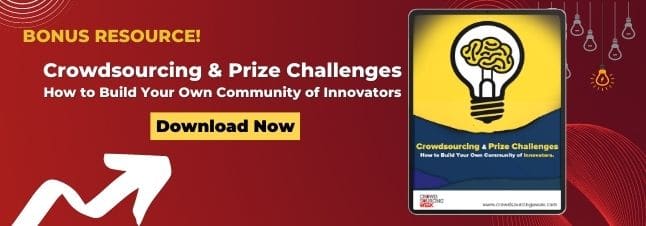This is the first part in a three-part blog series on using prize competitions, also called prize challenges. In this Part 1 we share the power and benefits of prize competitions. In Part 2 we will help you understand what makes a successful prize competition. And in Part 3, we’ll help you understand how to choose the appropriate crowd to compete for your prize competition.
Overview
Records of using prize competitions to accelerate innovation and R&D go back hundreds of years. In 1714 the British Government, after an increasing number of shipping disasters, passed an Act of Parliament to encourage finding an accurate way to determine longitude, and thus navigate the seas accurately, with a total prize value of £20,000 (today worth an estimated €1.8m). In the years since then, many other well-known innovations came about as a result of prize competitions, including canned food (a prize launched by Napoleon in 1795), modern plastics (the Billiard Ball Prize launched in 1863), transatlantic flight (a prize won by Charles Lindbergh in 1927) and educating kids in rural areas via software on a tablet (the Global Learning XPRIZE launched in 2014).
In fact, using prizes to accelerate R&D is witnessing a renaissance with many organizations and governments around the world launching prizes to accelerate R&D.
We see competition prizes offered by all types of commercial enterprises, non-profit organizations and governments, including Forbes, Coca-Cola, Toyota, NBC, Facebook, Shell, The Barbara Bush Foundation for Family Literacy, NextEra Energy, and NASA, to just name a few.
Prize challenges can spur all types of innovation and R&D. We’ve seen prize competitions range from generating ideas (e.g. on new products or services an organization can offer) to algorithms (e.g. for insurance companies updating their actuary tables), creative solutions (such as new commercials for consumer products or new company logos for) to prizes for developing new technology (e.g. new manufacturing techniques or totally new products), plus many more categories.
The question for anyone considering running a challenge competition is “Where is the blockage in my R&D pipeline – where can I use new and different ideas? An open innovation prize challenge just might be able to help you.
Benefits of Prize Challenges
There are clear benefits to hosting a prize competition. These include:
- Bringing in new ideas. Using a traditional grant or contract system is likely to be of interest only to current industry incumbents, and your fous would fall on known players in the relevant marketplaces. Yet people outside the existing pool of recognized “experts” have not grown accustomed to thinking only within certain empirical parameters or to existing industry or marketplace standards. Open innovation prize challenges attract and inspire people from around the world with a wider set of skills and experiences to compete to achieve your goal.
 For example, a NASA challenge to design a fold-away radiation shield targeted origami specialists – hardly a skill found among regular NASA employees. The $500 prize was awarded to Albertus Januardy, a Polish “environmental artist.”
For example, a NASA challenge to design a fold-away radiation shield targeted origami specialists – hardly a skill found among regular NASA employees. The $500 prize was awarded to Albertus Januardy, a Polish “environmental artist.”
Similarly, in the 1714 Longitude Prize – established to reward the precise determination of a ship’s longitude – everyone assumed a ship’s captain or astronomer would win, rather than be inspired by decades of work by the clockmaker John Harrison.
 In the 1919 Orteig prize for the first person to fly between New York and Paris non-stop, it was assumed the winner would be one of the contemporary aviation leaders of the time, though they all failed (some even died) because they were too conservative in the design of their planes and how they flew. Instead, this prize challenge was won by the relatively unknown 25-year-old mail pilot, Charles Lindbergh.
In the 1919 Orteig prize for the first person to fly between New York and Paris non-stop, it was assumed the winner would be one of the contemporary aviation leaders of the time, though they all failed (some even died) because they were too conservative in the design of their planes and how they flew. Instead, this prize challenge was won by the relatively unknown 25-year-old mail pilot, Charles Lindbergh.
- Leveraging your investment. Throughout the course of a competition, participants spend their own time and money to compete for the prize. In many instances, the teams spend R&D money that in total could be many times more than the value of the prize. A grant or contract worth $100,000 would fund $100,000 worth of research and development, whereas a prize with a purse of $100,000 could generate $1+ million worth of investment. In a time of fiscal constraint, prizes are an extremely efficient tool to help spur innovation. NASA got their design for a stowable radiation shield for a $500 prize!
- Encouraging risk. What separates challenge prizes from traditional R&D funding mechanisms is that the burden of risk is on the challengers, since the prize is designed only to reward success:
 you only pay when a challenger meets your goal. A traditional grant or contract would most likely be awarded to known players in a marketplace because that minimizes the risk of the money being wasted. Those known players will want to maintain their prestige through success, and so be less likely to take the risks that are necessary to result in a truly transformational breakthrough. Whereas industry-unknowns competing for a prize have little to lose and possibly much to gain by embracing risky solutions.
you only pay when a challenger meets your goal. A traditional grant or contract would most likely be awarded to known players in a marketplace because that minimizes the risk of the money being wasted. Those known players will want to maintain their prestige through success, and so be less likely to take the risks that are necessary to result in a truly transformational breakthrough. Whereas industry-unknowns competing for a prize have little to lose and possibly much to gain by embracing risky solutions.
It is Not Just About You – It’s Also About the Participants
So there are clear benefits of hosting an R&D prize competition, but you should also think about the participants because you will not be successful without them. They take on the risks of trying to deliver the solution you seek, spending their own time and money to compete. So, how do you make it rewarding and a no-brainer for them to participate? And not only in your current challenge but in subsequent ones as well.
Before entering a competition, participants generally balance the costs and the potential benefits of competing. The costs of competing include:
- the time and effort they must put in to compete,
- the opportunity costs of not pursuing other activities,
- the capital outlay to develop their solutions for the prize challenge.
When assessing the benefits of competing in a prize competition, participants know that only one or two or three of them will win the prize – so a well-designed prize offers numerous benefits to participants beyond just the main prize. You should include other incentives to encourage the maximum number of qualified teams to compete – all with the goal of having the greatest amount of innovation.
These incentives could include resources or benefits such as access to experts, potential funders, policy makers, and regulators; education, including business plan and fundraising training and market studies; media exposure, including brand promotion; partnership opportunities; investment by you to their company; and access to testing facilities and third-party verified data about their solutions. I will cover this more in Part 2.
And maybe it’s best not to behave like the British Government did. Although clockmaker John Harrison received interim payments, the Board of Longitude became very good at delaying the actual award of the Longitude Prize. His solutions “met the brief” though were too expensive to employ on a mass scale, or too complex for all mariners to use, they said, shifting the goalposts. Also, how long would his timepiece solutions continue to work in the corrosive air at sea? Lengthy trials were needed. He died 62 years after the Longitude Act was passed and his work was continued by other clock makers – none of whom were awarded the honor of being the ultimate prize winner.
Please keep an eye out for Parts 2 and 3 of this blog series. In Part 2 we help you understand what makes a successful prize competition. In Part 3 we’ll help you choose the appropriate crowd to compete for your prize competition.
Mobile Phones & Tablets
Sept. 24th
5 pm CET – European






0 Comments